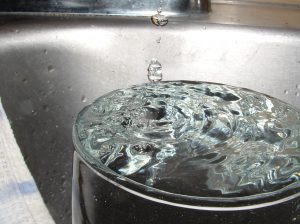 When you turn on a faucet in your home, you expect to see water that’s clear and clean. So, it can be disconcerting if the water has a cloudy or white appearance. The first thing that most people need to know is that the water is safe to drink and use for other tasks. Does this aesthetic change degrade the water for drinking, food prep, cleaning, and more? In this article, we will take a closer look at this phenomenon.
When you turn on a faucet in your home, you expect to see water that’s clear and clean. So, it can be disconcerting if the water has a cloudy or white appearance. The first thing that most people need to know is that the water is safe to drink and use for other tasks. Does this aesthetic change degrade the water for drinking, food prep, cleaning, and more? In this article, we will take a closer look at this phenomenon.
The Usual Cause is Air
The primary cause of white or cloudy water is air which may seem strange. The temperature difference between outdoors and indoors and the air pressure in the plumbing pipes can lead to the formation of tiny air bubbles. This can give the water a “milky” look when the water is initially drawn from the faucet. if this is the cause of your white colored water problems, you will notice that it tends to dissipate quickly. To test this theory, fill a glass with water and leave it to stand for at least ten minutes. When you look at the water closely, you may see that the cloudiness seems to clear at the bottom of the glass and then move upwards. This aesthetic change is caused because the trapped air bubbles are rising to the surface of the water, where they dissipate. This looks strange, but these tiny air bubbles do not compromise the drinking water safety.
How Does Air Become Trapped in Water?
This can happen in a number of ways. Cold groundwater may develop air bubbles when it’s brought to the surface where the temperature is warmer. Maintenance to water carrying pipelines can also introduce air because water lines are pressurized. The trapped air will tend to stay in the water until it’s released when you open the faucet.
Are the Any Other Causes?
Yes, although trapped air is the most common cause of white water, there are other causes to consider. The presence of cloudiness is often caused by turbidity issues. Turbidity is the suspension of fine matter particulates in the water. When the water is exposed to light, you may see these particles scatter, and this is what makes the water look cloudy. The particles found in water may be organic or inorganic, and they often have a detrimental effect on plumbing pipes, fixtures, and water using appliances. This is because fine particles may have an abrasive action that can etch sinks, glassware, dishes, and even the interior surfaces of water carrying pipes.
What is the Solution?
If you’re concerned about the color of your water, you can confirm the presence of air bubbles with the aforementioned test using a glass of water. But, if the water has a harsh metallic taste theory may be high concentrations of minerals present, including copper, iron, and more. In this case, it’s a good idea to invest in professional water testing to get a full understanding of the makeup of your water supply. The results of this test can help you to choose the right water treatment options to improve the water quality.
If you have water quality concerns, contact your local water treatment specialist for expert help and advice.
About The Author:
Greg Scott is President of Valparaiso based Miracle/EcoWater Systems, the premier water conditioning company in Northwest Indiana serving the Lake, Porter, and LaPorte County areas. A 3rd generation water treatment professional, Greg grew up in the family owned business started by his grandfather in the late fifties. He has made water treatment his life, and under his direction and high-standards, the company’s water treatment experience, knowledge, and products are unrivaled in the region.
